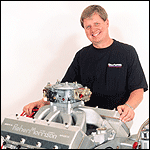 By David Reher, Reher-Morrison Racing Engines
By David Reher, Reher-Morrison Racing Engines
If a generation is roughly 25 years, I calculate that our sport is about to see its third generation of racers pull into the staging lanes. As NHRA celebrates its Golden Anniversary season, I’m grateful for the improvements in the quality of parts that the first two generations of racers have produced.
When I started racing years ago on dusty Southwestern drag strips, we expected to break parts. My friends didn’t ask me on Monday morning, “Did you win?” Rather, they wanted to know, “What did you break?” The station wagon rearends, junkyard 4-speeds and oddball parts that were the staples of our so-called racing program were the strongest pieces we could pull out Texas salvage yards – but they still couldn’t withstand the unreasonable demands of a bunch of neophyte drag racers.
Today’s drivetrain and engine components are stronger, more reliable and better engineered in every way. Advances in metallurgy have produced valve springs that can endure maximum lifts that were simply unimaginable a few years ago. Aftermarket axles can stand up to hundreds of full-throttle launches without flinching. Best of all, access to these pieces is as easy as picking up a telephone. I don’t miss the days of sorting through piles of grimy cylinder heads to find a pair of usable castings.
Statistically speaking, there has never been a better time to be a drag racer. But the problem with statistics is that they are averages. We know, for example, that your chances of being hit by a meteorite are miniscule – but that’s little consolation if you’re standing in the wrong spot when one lands.
It’s the same with racing engines. I’ve seen engines make 600 passes without a problem – and I’ve seen motors that self-destructed after only 30 runs. You might conclude from these statistics that the average life expectancy of a racing engine is 315 runs, but that certainly doesn’t reflect the reality of the situation.
You must be able to distinguish between types of failures. If an airplane is delayed while the mechanics repair a problem on the ramp, that’s just unscheduled maintenance. If an engine fails in flight, that’s a serious problem. The situation is the same with a racing engine: If your motor breaks a rod, that’s a catastrophic failure. When you perform an autopsy and find that the bearing didn’t spin and the engine didn’t have an oiling problem, then all you can say is that the rod failed prematurely. It was the exception that lowered the statistical average.
As the quality and longevity of parts have improved, there is a natural tendency for racers to become complacent. It’s rare these days to see a broken valve spring when you pull off the valve covers. But it is still vitally important that you look, instead of just assuming that the valvetrain is OK. Personally, I’m delighted when I remove a valve cover and find everything in perfect working order.
I recognize that when you are running round-robin in eliminations that you can’t look at the valve springs after every run. But you can check them, along with the oil filter and a magnetic oil pan plug, at regular intervals when you’re not racing on the track.
The most important preventive maintenance you can perform is to check the valve lash. A common problem I see in bracket engines these days is broken roller lifters. Not instant destruction caused by valve float, but wear and fatigue that gradually grind down the needle rollers inside the lifter wheel. As these highly loaded needle bearings start to break up, the valve lash increases dramatically.
If you check the valve lash religiously, you can spot these problems before they cause further damage. But if lifter problems aren’t detected early, the needles will be pulverized and the roller wheel will recede into the lifter body. When that happens, the lifter body grinds into the camshaft lobe and you get metal filings everywhere – on the cylinder walls, in the piston skirts and in the bearings.
A broken lifter is the most destructive component failure short of a broken connecting rod. Every time we overhaul a motor, we examine the used roller lifters very carefully. We install the highest quality lifters we can find, but our experience (and the statistics) proves that there will be random problems.
A simple act of preventive maintenance like routinely checking valve lash can save a racer a lot of money. If the lash is just where you set it, be happy – but please don’t forget to check it again before the next race.
